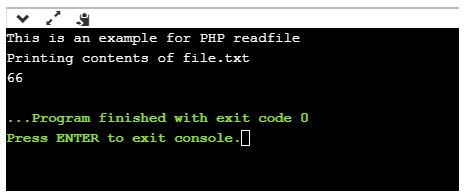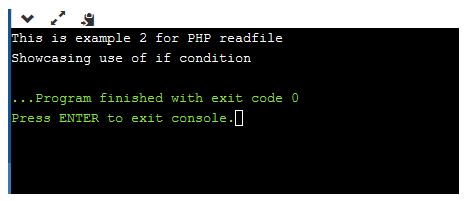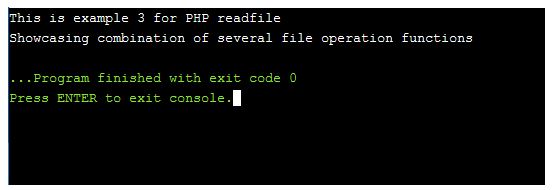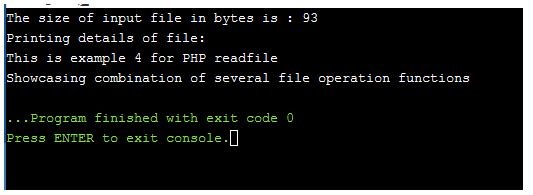PHP readfile is basically an inbuilt function in the PHP library used for reading a file and then writing it to an output buffer.
Start Your Free Software Development Course
Web development, programming languages, Software testing & others
Syntax:
readfile ( string $file_name [, boolean $path = FALSE [, resource $context ]] ) : int
The parameters being used in the syntax:
- filename:?It is a mandatory field where we provide the name of the file to be read.
- path:?This is an optional parameter and is a boolean value that can be set to either true or false if the file needs to be searched in the provided path.
- context:?This is also an optional field which is used to specify the context of the file handle. Basically a context is a collection of objects having an ability to change the behavior of that stream. It returns the number of bytes which is read from the file if success and returns false if failed to read.
Methods of PHP readfile
Apart from readfile() function, below are some of the other functions that can be used for performing various kinds of operations on the files.
1. file()
This function is also used to read a file and it reads the complete file into an array.
Syntax:
file?(?string?$file_name?[,?int?$flag?= 0?[,?resource?$context?]] ) :?array
where file_name is the path to the file to be read. Flags are the optional fields which can be chosen from the below constants:
- FILE_USE_INCLUDE_PATH:?To search for the respective file in the given path.
- FILE_IGNORE_NEW_LINES:?To omit a new line at the last of each array element.
- FILE_SKIP_EMPTY_LINES:?To skip empty lines.
It returns the file present in the array upon success and false upon failure.
2. fopen()
This function can be used to open both a file and a URL.
fopen?(?string?$file_name?,?string?$mode?[,?bool?$use_include_path?=?FALSE?[,?resource?$context?]] ) :?resource
- where if file_name is a URL then PHP searches a protocol handler (also called as a wrapper) for it. The PHP will issue a notice to help track possible problems in the script and then continue considering it as a normal regular file_name.
- Suppose if the file_name is a local file then PHP tries to open the same stream on that file. The file will be accessible by PHP only if required permissions are granted for its access.
- And suppose the given file_name is a registered protocol and if that one is registered as a network URL then the first PHP ensures that the allow_url_fopen is enabled. It will issue a warning and fail if it is disabled.
Mode:?This parameter mentions the kind of access required to be given to the stream.’? Below are few important modes:
- r – read mode only
- r+ – both read and write only
- w – write mode only
It returns a file pointer resource if success and false on failure.
3. fread()
This function is used for binary-safe file read.
Syntax:
fread?(?resource?$handle?,?int?$length?) :?string
where the handle is used for referencing the file pointer.
The file is read until it reaches one of the below conditions: length in bytes must have been read, EOF is reached, socket timeout occurs. fgets(), fscanf(), ftell(), fwrite(), fopen(), fsockopen() are a few other functions used for file operations in PHP.
Examples of?PHP readfile
Given below are the examples of PHP readfile:
Example #1
Code:
<?php
// it is writing content of file to output
// buffer used in readfile() function
echo readfile("file.txt");
?>
Output:

This shows a basic example to read a file existing in the local path. Make sure that the filename being specified in the parameter of readfile() function is created and the content to be read is present inside the file. When the readfile() function is used it reads the content of the file and prints in the output.
Example #2
Code:
<?php
/ file contents written on output
// buffer by readfile() function
$file = @readfile("file.txt");
if (!$file)
{
print "File could not be opened";
}
?>
Output:

The previous output was a simple example without any conditions. In this example, let us see how to read and display the output of a file by using certain conditions. We are using if statement to print suppose the file is not present.
Example #3
Code:
<?php $file_name = "file.txt"; $fh = fopen($file_name, 'r'); $data = fread($fh, filesize($file_name)); fclose($fh); echo $data; ?>
Output:

In this example, we are combining the use of multiple file read functions. As in all the above examples, first, we are giving the file name which needs to be read from. Then the mode of operation, ‘r’ is given to them indicating it can only be read. filesize() function takes the filename and returns the size of the file along with its data and assigns it to $data variable. By using fclose() function we are closing that file. Finally, the data is printed as output.
Example #4
Code:
<?php
$file_name = "file.txt";
$file = fopen( $file_name , "r" );
if( $file == false ) {
echo ( "Error in opening file" );
exit();
}
$size = filesize( $file_name );
$filetext = fread( $file, $size);
fclose( $file );
echo ( "The size of input file in bytes is : $size\n" );
echo ("Printing details of file:\n");
echo ( $filetext );
?>
Output:

Before running the code, make sure that the file to be read file.txt is created in the local file path. In this example first, we are declaring the file name to be read and opening that with the function fopen(). Suppose the file does not exist, using if condition we are throwing an error message. Finally, we are printing the file size and the content present in the input file.
Conclusion
As seen from all the above examples, readfile() is one of the main functions of PHP used for reading the file name specified in this function. Apart from readfile() we have covered a few other file operations which perform similar actions such as fopen, file, fread, fgets, fgetss, ftell, etc. A combination of all of these are basically used in accessing and performing operations on the input file.
The above is the detailed content of PHP readfile. For more information, please follow other related articles on the PHP Chinese website!

Hot AI Tools

Undress AI Tool
Undress images for free

Undresser.AI Undress
AI-powered app for creating realistic nude photos

AI Clothes Remover
Online AI tool for removing clothes from photos.

Clothoff.io
AI clothes remover

Video Face Swap
Swap faces in any video effortlessly with our completely free AI face swap tool!

Hot Article

Hot Tools

Notepad++7.3.1
Easy-to-use and free code editor

SublimeText3 Chinese version
Chinese version, very easy to use

Zend Studio 13.0.1
Powerful PHP integrated development environment

Dreamweaver CS6
Visual web development tools

SublimeText3 Mac version
God-level code editing software (SublimeText3)

Hot Topics
 How do I stay up-to-date with the latest PHP developments and best practices?
Jun 23, 2025 am 12:56 AM
How do I stay up-to-date with the latest PHP developments and best practices?
Jun 23, 2025 am 12:56 AM
TostaycurrentwithPHPdevelopmentsandbestpractices,followkeynewssourceslikePHP.netandPHPWeekly,engagewithcommunitiesonforumsandconferences,keeptoolingupdatedandgraduallyadoptnewfeatures,andreadorcontributetoopensourceprojects.First,followreliablesource
 What is PHP, and why is it used for web development?
Jun 23, 2025 am 12:55 AM
What is PHP, and why is it used for web development?
Jun 23, 2025 am 12:55 AM
PHPbecamepopularforwebdevelopmentduetoitseaseoflearning,seamlessintegrationwithHTML,widespreadhostingsupport,andalargeecosystemincludingframeworkslikeLaravelandCMSplatformslikeWordPress.Itexcelsinhandlingformsubmissions,managingusersessions,interacti
 How to set PHP time zone?
Jun 25, 2025 am 01:00 AM
How to set PHP time zone?
Jun 25, 2025 am 01:00 AM
TosettherighttimezoneinPHP,usedate_default_timezone_set()functionatthestartofyourscriptwithavalididentifiersuchas'America/New_York'.1.Usedate_default_timezone_set()beforeanydate/timefunctions.2.Alternatively,configurethephp.inifilebysettingdate.timez
 How do I validate user input in PHP to ensure it meets certain criteria?
Jun 22, 2025 am 01:00 AM
How do I validate user input in PHP to ensure it meets certain criteria?
Jun 22, 2025 am 01:00 AM
TovalidateuserinputinPHP,usebuilt-invalidationfunctionslikefilter_var()andfilter_input(),applyregularexpressionsforcustomformatssuchasusernamesorphonenumbers,checkdatatypesfornumericvalueslikeageorprice,setlengthlimitsandtrimwhitespacetopreventlayout
 What is data serialization in PHP (serialize(), unserialize())?
Jun 22, 2025 am 01:03 AM
What is data serialization in PHP (serialize(), unserialize())?
Jun 22, 2025 am 01:03 AM
ThePhpfunctionSerialize () andunserialize () AreusedtoconvertcomplexdaTastructdestoresintostoraSandaBackagain.1.Serialize () c OnvertsdatalikecarraysorobjectsraystringcontainingTypeandstructureinformation.2.unserialize () Reconstruct theoriginalatataprom
 How do I embed PHP code in an HTML file?
Jun 22, 2025 am 01:00 AM
How do I embed PHP code in an HTML file?
Jun 22, 2025 am 01:00 AM
You can embed PHP code into HTML files, but make sure that the file has an extension of .php so that the server can parse it correctly. Use standard tags to wrap PHP code, insert dynamic content anywhere in HTML. In addition, you can switch PHP and HTML multiple times in the same file to realize dynamic functions such as conditional rendering. Be sure to pay attention to the server configuration and syntax correctness to avoid problems caused by short labels, quotation mark errors or omitted end labels.
 What are the best practices for writing clean and maintainable PHP code?
Jun 24, 2025 am 12:53 AM
What are the best practices for writing clean and maintainable PHP code?
Jun 24, 2025 am 12:53 AM
The key to writing clean and easy-to-maintain PHP code lies in clear naming, following standards, reasonable structure, making good use of comments and testability. 1. Use clear variables, functions and class names, such as $userData and calculateTotalPrice(); 2. Follow the PSR-12 standard unified code style; 3. Split the code structure according to responsibilities, and organize it using MVC or Laravel-style catalogs; 4. Avoid noodles-style code and split the logic into small functions with a single responsibility; 5. Add comments at key points and write interface documents to clarify parameters, return values ??and exceptions; 6. Improve testability, adopt dependency injection, reduce global state and static methods. These practices improve code quality, collaboration efficiency and post-maintenance ease.
 How do I execute SQL queries using PHP?
Jun 24, 2025 am 12:54 AM
How do I execute SQL queries using PHP?
Jun 24, 2025 am 12:54 AM
Yes,youcanrunSQLqueriesusingPHP,andtheprocessinvolveschoosingadatabaseextension,connectingtothedatabase,executingqueriessafely,andclosingconnectionswhendone.Todothis,firstchoosebetweenMySQLiorPDO,withPDObeingmoreflexibleduetosupportingmultipledatabas






